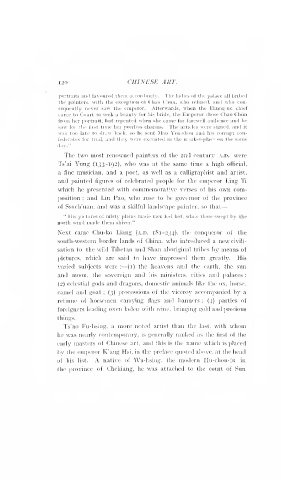Page 374 - Chinese Art, Vol II By Stephen W. Bushell
P. 374
120 CHINESE ART. —
portraits and favoured them accordingly. The ladies of the palace all bribed
the painters, with the exception of Chao Chiin, who refused, and who con-
sequently never saw the emperor. Afterwards, when the Hiung-nu chief
came to Court to seek a beauty for his bride, the Emperor chose Chao Chiin
from her portrait, but repented when she came for farewell audience and he
saw for the first time her peerless charms. The articles were signed, and it
was too late to draw back, so he sent Mao Yen-shou and his corrupt con-
federates for trial, and they were executed in the market-plac" on the same
day."
The two most renowned painters of the 2nd century .^.D. were
Ts'ai Yung (133-192), who was at the same time a high official,
a fine musician, and a poet, as well as a calligraphist and artist,
and painted figures of celebrated people for the emperor Ling Ti
which he presented with commemorative verses of his own com-
position ; and Liu Pao, who rose to be governor of the province
of Ssuch'uan, and was a skilful landscape painter, so that
" His pictures of misty plains made men feel hot. while those swept by the
north wind made them shiver."
Next came Chu-ko Liang (.\.d. iSi-234), the conqueror of the
south-western border lands of China, who introduced a new civili-
sation to the wild Tibetan and Shan aboriginal tribes by means of
pictures, which are said to have impressed them greatly. His
varied subjects were — (i) the heavens and the earth, the sun
:
and moon, the sovereign and his ministers, cities and palaces
;
(2) celestial gods and dragons, domestic animals like the ox, horse,
camel and goat processions of the viceroj' accompanied by a
; (3)
retinue of horsemen carrjnng flags and banners parties of
; (4)
foreigners leading oxen laden with wine, bringing gold and precious
things.
Ts'ao Fu-hsiug, a more noted artist than the last, with whom
he was nearly contemporary, is generally ranked as the first of the
early masters of Chinese art, and this is the name which is placed
by the emperor K'ang Hsi, in the preface quoted above, at the head
of his list. A native of Wu-hsing, the modern Hu-chou-fu in
the province of Chekiang, he was attached to the court of Sun

